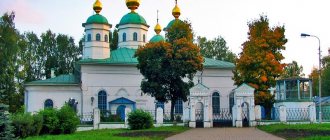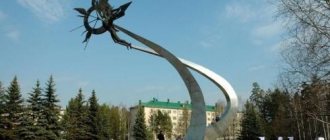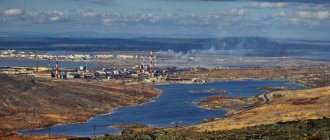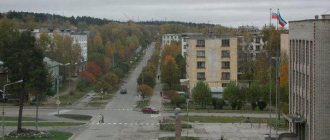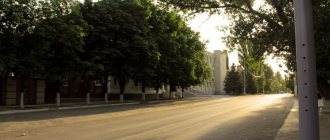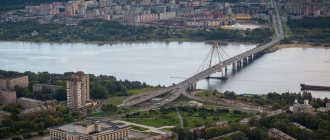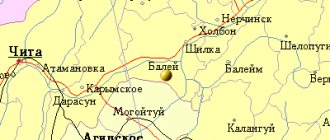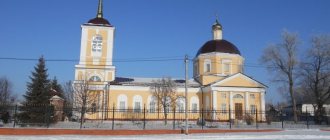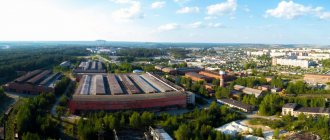Coat of arms of the urban district of Vyksa
The coat of arms of the urban district of the city of Vyksa, Nizhny Novgorod region is the official symbol of the urban district of the city of Vyksa, Nizhny Novgorod region.
Heraldic description of the coat of arms of the city district:
“In a four-part field of scarlet, green, azure and scarlet is a rising silver unicorn.”
Decision of the Council of Deputies of the urban district of the city of Vyksa dated 02/28/2017 No. 7 “On the coat of arms of the urban district of the city of Vyksa of the Nizhny Novgorod region”
Flag of the Vyksa urban district
The flag of the urban district of the city of Vyksa of the Nizhny Novgorod region is the official symbol of the urban district of the city of Vyksa of the Nizhny Novgorod region.
Description of the city district flag:
“A rectangular double-sided panel with a width to length ratio of 2:3, composed of 4 equal rectangular parts, red and green at the top, blue and red at the bottom. In the center of the panel, the figure of a white unicorn from the coat of arms of the urban district of the city of Vyksa, Nizhny Novgorod region, is reproduced.”
Decision of the Council of Deputies of the urban district of the city of Vyksa dated 02.28.2017 No. 8 “On the flag of the urban district of the city of Vyksa of the Nizhny Novgorod region”
Must-see places in Vyksa: TOP 4 places
Vyksa is a cozy, actively developing city with its own flavor and characteristics, where the industrial past coexists with the bright and colorful present, tourists can expect the most diverse attractions. The most interesting objects that are worth seeing first are described first.
House of Batashevs
- Address: Lenin street, 5.
The formation and development of metallurgy in Vyksa is associated with the names of famous factory owners of the 18th century - the Batashev brothers - Ivan Rodionovich and Andrei Rodionovich. They became the founders of an iron ore enterprise in Vyksa. A manor-industrial complex was created here.
The central place in the complex, which determined the architectural appearance of old Vyksa, was occupied by a manor house built in 1765-1770. Initially, the building was two-story, but by the end of the century, on the orders of Ivan Batashev, the third floor was completed. There were 40 rooms in total, including state rooms - “Italian”, “Chinese” and “Turkish”, named after the style of the interior decoration.
After the death of I.R. Batashev's house passed to his relative, General Shepelev. In some sources, the architectural landmark appears as the “Batashev-Shepelev House”. The building went through several reconstructions and had different purposes. During Soviet times, party institutions were located here, and for some time there was an armory.
Museum of the History of the Metallurgical Plant
- Address: st. Lenina, 5.
Today the building of the Batashev mansion is used in accordance with its historical role. There is an exhibition there, officially called the Museum of the History of the Metallurgical Plant, but in fact performing the functions of a local history museum - the main city one. The main theme, of course, is industrial; in the historical part, the central place is occupied by examples of cast iron castings, materials about the plant and the dynasty of its founders.
In addition to the historical part, there are art and literary departments. In the 40s and 50s of the 19th century, the famous playwright and philosopher Alexander Sukhovo-Kobylin lived in Vyksa.
There is information that it was here, in the Batashev mansion, that his famous play “Krechinsky’s Wedding” was written. This fact is also reflected in the exhibition - a separate exhibition is dedicated to the author. The artistic part is based on items from the Batashevs’ personal collection. These are both examples of fine art, as well as household and interior items that remember the famous owners of the estate.
Church of the Nativity
- Address: Sovetskaya Square.
The cathedral, consecrated in honor of the Nativity of Christ, located on the central square of the city, is often called the real “pride of Vyksa.” The temple appeared in 1773 on the initiative and with the financial participation of the Batashev brothers.
The two-story building, belonging to the Baroque architectural style, is crowned by an interestingly shaped dome, equipped with hatch windows and ending with a small dome; the architectural appearance also features a portico with columns. The cathedral is complemented by a majestic four-tier bell tower. The religious building is decorated in white and yellow tones and looks strict and solemn.
In the 20th century, the history of the cathedral was affected by the policy of persecution of the church; its rector was arrested, and the cathedral itself was closed in 1937. A revival of life, accompanied by restoration work, took place in the 1990s and early 2000s. Now the temple operates, remaining the main one in the city.
Park of Culture and Recreation
- Address: st. Academician Korolev, 2.
Vyksa Park is a symbol of the city; it is often mentioned in the same breath as the Summer Garden, the parks of Peterhof and even Versailles in Paris. Actually, these famous monuments of landscape art served as the “prototype” for the gunsmith brothers who laid out Vykse Park. It was settled by Batashevsky serfs in accordance with European trends of the time, combining elements of English and French style. “A huge park-garden with grandiose alleys,” V. Bezborodov wrote about it in the 19th century.
Today, the former Batashev estate park is the center of city life, one of the sites of the Art-Ovrag festival, which has been taking place in the city since 2011. Numerous monuments and art objects for which Vyksa is famous are located here. The historical appearance has only been partially preserved. As before, as now, the park’s plantings are predominantly linden trees; it attracts visitors with its interesting topography. The park immerses visitors in a special atmosphere and color; by visiting here you can “feel the spirit” of the city of Vyksa.
Symbolism
Wooden sculpture of a unicorn - the official symbol of the city.
Kio City Park The official symbols of Vyksa - the coat of arms and the flag were adopted on February 28, 2017. The composition of the coat of arms is a four-part (scarlet, green, azure and scarlet) French heraldic shield with a rising silver unicorn. Entered into the State Heraldic Register under number 11362. The flag is a rectangular double-sided panel with a width to length ratio of 2:3, composed of four equal rectangular parts, red and green at the top, blue and red at the bottom. In the center of the panel, the figure of a white unicorn from the city’s coat of arms is reproduced.
The symbolism reflects local characteristics associated with the history of the development of the metallurgical industry in Vyksa. The silver unicorn, which is also the family coat of arms of the founders of the Vyksa factories, the Batashov brothers, symbolizes unity, spiritual power and nobility. Each part of the four-part shield also carries a certain meaning: scarlet (red color) - the color of hot metal, symbolically reflects the role of metallurgy in the formation and development of the city, symbolizes labor, courage, life-affirming force, beauty, holiday; green color is a symbol of the nature of the city, the surrounding forests and fields, city parks, symbolizes life, prosperity, stability, hope; azure - a color symbolizing water spaces, allegorically reflects the origin of the name “Vyksa”. It is a symbol of truth, honor and virtue, clear skies[10].
Architectural and industrial landmarks
Since ancient times, peoples of the Finno-Ugric group lived in Vyksa, which is why the name of the settlement is usually traced back to the Finnish word vuoksi, which means “stream”, “current”. As a city, Vyksa is less than a century old; the corresponding status was assigned in 1934, but the history of the settlement and the development of these places dates back to the 16th century. Many historical attractions here are associated with architecture and industry.
Vyksa Metallurgical Plant
- Address: Batashev Brothers Street, 45.
The metallurgical plant in Vyksa, a direct successor to the Batashevsky enterprise, which opened in 1557, continues to operate successfully to this day, located on the street named after its founders.
It is one of the fastest growing factories in the industry and participates in Russian and international projects. Pipes for Nord Stream were manufactured here; since 1999, the Vyksa plant has been part of the United Metallurgical Company.
Runt house and horse yard
- Address: st. Lenina, 32.
The Batashev plant had its own security. Conditional predecessors of modern Chopovites in the 18th century. were called runts. A special house was built for them in the industrial estate building.
Lancet windows and turrets, which determine the unique appearance of the building, refer to the Gothic style. This type of architecture was in vogue at the end of the 18th century and was called false Gothic. In this spirit, the “residential quarter” of the factory settlement was built.
Similar trends are demonstrated by the building of the horse yard, located next to the runt house. In its architecture there is a juxtaposition of two styles and two periods - classicist and gothic.
Shukhov water tower
- Address: territory Prommikroraion No. 15.
An object of architectural heritage in Vyksa is a water tower, created according to a system developed by the famous engineer V. Shukhov. He presented his invention to the public in 1896 in Nizhny Novgorod, since then “Shukhov towers” began to appear in different cities of the country, Vyksa was one of the first among them. A water pumping structure made of steel rods appeared here.
Hunting lodge of Ivan Batashev
- Address: working village Doschatoye.
A remarkable historical and architectural landmark has been preserved in the vicinity of the city of Vyksa - in the village of Doschatoe, located right off the Oka shores. The brick structure, surrounded by a wooden fence, resembles a small castle with its columns and “rounded shapes.”
This is one of the heritage sites of Ivan Batashev - a hunting lodge. It was rumored that the breeder initiated its construction to heal his mentally ill son. History has preserved the name of the serf Mikhail Kiselnikov, who acted as the architect of this once majestic structure.
At one stage of its history, the building happened to be a medical institution; the house underwent redevelopment and lost part of its historical appearance. It is now in disrepair. Available for external inspection.
Notes
- Chemodanov L.A.
History of the Gorky region. Tutorial. - Gorky: Volga-Vyatka Book Publishing House, 1975. - P. 198. - 200 p. - ↑ 123
Population of the Russian Federation by municipalities as of January 1, 2022 (Russian). Date accessed: October 17, 2022. Archived October 17, 2022. - THE USSR. Administrative-territorial division of the union republics on January 1, 1980 / Comp. V. A. Dudarev, N. A. Evseeva. - M.: Izvestia, 1980. - 702 p. — P. 118.
- Settlements of the Vyksa region (undefined)
(inaccessible link -
history
). - L. Trube.
How did the geographical names of the Gorky region originate? - Gorky: Gorky Book Publishing House, 1962. - P. 102. - 192 p. - Vyksa... What's in my name for you? :: Vyksa worker (undefined)
. vr-vyksa.ru. Access date: November 13, 2022. - ↑ 1 2 3
VYKSUNSKY MZ
(unspecified)
(inaccessible link -
history
). - Morokhin N.V.
Our rivers, cities and villages. - Nizhny Novgorod: Books, 2007. - 429 p. — ISBN 978-5-94706-032-4. - All-Russian Central Executive Committee. Resolution of October 20, 1933 “On changes in the administrative-territorial structure of the Gorky Territory” (unspecified)
. Archived from the original on June 14, 2015. - Coat of arms of the city of Vyksa | Geraldika.ru (unspecified)
. geraldika.ru. Date accessed: February 28, 2022. - ↑ 12345678910111213
People's encyclopedia "My City". Vyksa - All-Union Population Census of 1959. The size of the urban population of the RSFSR, its territorial units, urban settlements and urban areas by gender (Russian). Demoscope Weekly. Access date: September 25, 2013. Archived April 28, 2013.
- All-Union Population Census of 1970 The size of the urban population of the RSFSR, its territorial units, urban settlements and urban areas by gender. (Russian). Demoscope Weekly. Access date: September 25, 2013. Archived April 28, 2013.
- All-Union Population Census of 1979 The size of the urban population of the RSFSR, its territorial units, urban settlements and urban areas by gender. (Russian). Demoscope Weekly. Access date: September 25, 2013. Archived April 28, 2013.
- National Economy of the USSR 1922-1982 (Anniversary Statistical Yearbook)
- National economy of the USSR for 70 years: anniversary statistical yearbook: [arch. June 28, 2016] / USSR State Committee on Statistics. - Moscow: Finance and Statistics, 1987. - 766 p.
- All-Union population census of 1989. Urban population (undefined)
. Archived from the original on August 22, 2011. - Resolution of the Legislative Assembly of the region dated June 17, 1999 No. 184 “On establishing a formula for calculating the amount of the single tax on imputed income, the value of the basic profitability, increasing (decreasing) coefficients in the field of retail trade in the Nizhny Novgorod region” (undefined)
. Retrieved May 2, 2016. Archived May 2, 2016. - ↑ 1 2
All-Russian population census 2010.
Number and distribution of the population of the Nizhny Novgorod region (unspecified)
. Retrieved July 30, 2014. Archived July 30, 2014. - ↑ 123
Nizhny Novgorod Region. Estimated resident population as of January 1, 2008-2016 - Population of the Russian Federation by municipalities. Table 35. Estimated resident population as of January 1, 2012 (unspecified)
. Retrieved May 31, 2014. Archived May 31, 2014. - Population of the Russian Federation by municipalities as of January 1, 2013. - M.: Federal State Statistics Service Rosstat, 2013. - 528 p. (Table 33. Population of urban districts, municipal districts, urban and rural settlements, urban settlements, rural settlements) (undefined)
. Retrieved November 16, 2013. Archived November 16, 2013. - Table 33. Population of the Russian Federation by municipalities as of January 1, 2014 (unspecified)
. Access date: August 2, 2014. Archived August 2, 2014. - Population of the Russian Federation by municipalities as of January 1, 2015 (unspecified)
. Access date: August 6, 2015. Archived August 6, 2015. - Population of the Russian Federation by municipalities as of January 1, 2016 (Russian) (October 5, 2018). Retrieved May 15, 2022. Archived May 8, 2022.
- Population of the Russian Federation by municipalities as of January 1, 2022 (Russian) (July 31, 2017). Retrieved July 31, 2022. Archived July 31, 2022.
- Population of the Russian Federation by municipalities as of January 1, 2022 (Russian). Retrieved July 25, 2018. Archived July 26, 2022.
- Population of the Russian Federation by municipalities as of January 1, 2022 (Russian). Retrieved July 31, 2019. Archived May 2, 2022.
- taking into account the cities of Crimea
- https://rosstat.gov.ru/storage/mediabank/bul_Chislen_nasel_MO-01-01-2021.rar Population of the Russian Federation by municipalities as of January 1, 2022 (1.85 Mb, 07/30/2021)
- Virtual Vyksa (undefined)
. Archived March 22, 2009. - People's catalog of Orthodox architecture (undefined)
. Archived January 12, 2007. - Calculation of distances between cities (undefined)
. Rudorogi ROSTPAY LLC. - Description of the railway in Vyksa
- Vyksa diocese - General information (unspecified)
. vyksa-eparhia.ru. Date accessed: February 28, 2022. - ↑ 12
Vyksa Iversky Convent, Vyksa Deanery District - Nun Antonia (Mironova): “Numerous miracles happen before our icon,” Nizhny Novgorod diocese, October 26, 2009
- Vyksa Theological School celebrates the day of remembrance of its heavenly patron, Nizhny Novgorod diocese, October 9, 2009
- People's catalog of Orthodox architecture (undefined)
. Archived from the original on June 24, 2015. - Arsentiev N. M., Dubodel A. M.
We are obliged to serve the Fatherland... Labor motivation and the image of a Russian entrepreneur: history and modernity. - St. Petersburg: Nauka, 2000. - 320 p. — ISBN 5-7131-0053-7. - ↑ 1 2
Theatrical life of Vyksa
(undefined)
(inaccessible link -
history
). - Russian biographical dictionary.
- NTA-PRIVOLZHIE (undefined)
. Archived November 13, 2014. - Inauguration of the Torre Trémula tower designed by the architect Lorenzo Fernandez-Ordóñez.
- ↑ 12
Theater Vyksa - Makovskys
- Moscow magazine, No. 2, February, 2000 (unspecified)
(inaccessible link). Access date: October 21, 2009. Archived December 3, 2013. - History in the paintings of Nevrev N.V. (undefined)
(inaccessible link -
history
). - TALENTS AND PASTERS FROM VYKSA. Moscow magazine, 2000 (unspecified)
(inaccessible link). Access date: October 21, 2009. Archived December 3, 2013. - Shukhov water tower
- unofficial website of the Vyksa branch of MISiS (unspecified)
. Archived March 11, 2010. - Vyksa was visited by the official delegation of the city of Zhlobin of the Republic of Belarus (unspecified)
.
Vyksa temples and monasteries
There are also historical places of a religious nature in Vyksa and its surroundings - temples and cathedrals, churches, monasteries and monasteries. We will describe the most famous ones below.
Iversky Monastery
- Address: Lepse street.
The current Orthodox women's monastery in Vyksa is experiencing a “new stage” in its history, having been revived after being forgotten during the Soviet era. Since 1991, the monastic objects have been revived.
The appearance of the monastery in Vyksa is associated with the name of St. Barnabas of Gethsemane, a novice of the monastery of the same name of the Trinity-Sergius Lavra. In the world his name was Vasily Merkulov. The religious figure, canonized, arrived in the village of Vyksa in 1864, founding a monastery here. The dawn of the monastery came at the turn of the 19th-20th centuries, approximately 1887-1921. Afterwards, the monastery underwent partial closure, and then liquidation. In the 1930s, many of its buildings were destroyed.
The proximity of the two eras is illustrated by the current temple, the Church of the Life-Giving Trinity. The newly rebuilt attractive church, decorated in turquoise and white tones, adjoins the ruins of a destroyed historical building on the west, originally erected in 1904 according to the design of the architect P. Vinogradov.
Church of St. John the Evangelist
- Address: st. Lenina, 69.
The temple, illuminated in 1799, is also the brainchild of Ivan Batashev. In the middle of the 19th century, the Church of St. John the Evangelist underwent reconstruction, it was expanded, and a refectory was added. The church acquired a more solemn appearance and began to resemble a ship in appearance. Religious services were interrupted in 1936, the temple was closed. In 1994, restoration began, which lasted until 2006, when the church again began to receive parishioners.
Temple of Barnabas of Gethsemane
- Address: Sobornaya sq., 1.
The Varnavinskaya Church is a product of the post-Soviet era; it decorated Vyksa Cathedral Square at the end of the 20th century, in 1999. Built according to the well-known principle of “octagon on quadrangle”, the brick temple covered with white plaster became a kind of tribute to the religious history of the area - it was dedicated to the founder of the local monastery.
Population
| Population | ||||||||||
| 1897 | 1931[11] | 1939[11] | 1959[12] | 1967[11] | 1970[13] | 1979[14] | 1982[15] | 1986[11] | 1987[16] | 1989[17] |
| 8200 | ↗15 500 | ↗26 500 | ↗40 275 | ↗43 000 | ↗46 371 | ↗53 685 | ↗57 000 | ↗59 000 | ↗60 000 | ↗61 149 |
| 1992[11] | 1996[11] | 1998[11] | 1999[18] | 2000[11] | 2001[11] | 2002[19] | 2003[11] | 2005[11] | 2006[11] | 2007[11] |
| ↗62 700 | ↗63 400 | →63 400 | ↘63 200 | ↘62 800 | ↘62 200 | ↘61 657 | ↗61 700 | ↘59 600 | ↘58 600 | ↘57 900 |
| 2008[20] | 2009[20] | 2010[19] | 2011[20] | 2012[21] | 2013[22] | 2014[23] | 2015[24] | 2016[25] | 2017[26] | 2018[27] |
| ↘57 213 | ↘56 529 | ↘56 201 | ↘56 092 | ↘55 486 | ↘54 784 | ↘54 163 | ↘53 628 | ↘53 477 | ↘53 406 | ↘53 219 |
| 2019[28] | 2020[2] | |||||||||
| ↘52 822 | ↗53 010 | |||||||||
As of January 1, 2022, in terms of population, the city was in 306th place out of 1,116[29]cities of the Russian Federation[30].
Where to take a walk in Vyksa: streets and parks
There is also entertainment for children and adults in Vyksa - first of all, these are city parks, squares and alleys decorated with sculptural compositions.
Metallurgists' Alley
- Coordinates on the map: 55.319213, 42.172417.
In 2007, the Vyksa plant celebrated its 250th anniversary. On this occasion, an alley was laid out in the city, where the central place is occupied by busts of important people for the industrial history of the city - the Batashevs, Shepelev, Lessing. The alley, designed in the spirit of the century before last, complemented the appearance of the historical part of the city, becoming a favorite place for walks for residents and guests of Vyksa.
Krasnye Zori Street
- GPS coordinates: 55.330358, 42.160622.
One of the calling cards of Vyksa is a long artery starting in the central part of the current city. Krasnye Zori Street is a legacy of the Soviet era; it arose in 1928 during the construction of the Village of the 11th Anniversary of the October Revolution. This working street, originally consisting of wooden apartment buildings, was dubbed the “daughter of the first five-year plans.”
In the modern era, the city festival “Art Ravine” has left an indelible mark on the appearance of the street; here you can see works of street art created by artists from different cities of Russia. They appeared here in 2012-2013.
Recently, an art object called “Cage” was installed on the street. The work of sculptor Gleb Kiselev became a gift to the city from the entrepreneur, owner of the Glamourshowroom brand Sofia Eliseeva.
Street art in Zhukovsky
- Address: Zhukovsky microdistrict.
Works of contemporary graffiti art can be found in different parts of the city, but the Zhukovsky microdistrict, where the most famous works are located, is considered especially noteworthy in this regard.
Among them is an image of a flamingo the size of a residential building. An entire wall of the Soviet five-story building is occupied by graffiti, referencing the popular children's work by E. Schwartz “The Tale of Lost Time.”
Alley of Youth
- Coordinates: 55.325907, 42.186772.
The idea of creating a new pedestrian zone in the city at the intersection of Ostrovsky and Academician Korolev streets was expressed in 2009 by a local deputy. A year later, the “Alley of Youth” was opened. What makes it remarkable are the colorful posters with quotes from literary works and aphorisms. They are the work of participants in the Art Ravine festival.
Vyksa Ponds
- Coordinates: 55.309442, 42.204808.
Vyksa ponds are often called the “blue necklace” of Vyksa. But these are not natural bodies of water, but the creation of human hands. The ponds were created at the end of the 18th – beginning of the 19th century during the construction of the Vyksa hydraulic system, necessary for the operation of the metallurgical plant.
The ponds on the territory of the city are witnesses to the development of the metallurgical industry in the area. The most famous are the Upper, Lower and Reserve ponds. Today they are a favorite vacation spot in both summer and winter. In summer, water lovers can sunbathe, swim, and boat here, and in winter, the ponds attract fishermen.
Iversky Square
- Address: Spartak street.
In 2012, on the territory adjacent to the Iversky Monastery, a park was laid out, consisting of decorative tree species unusual for city parks. There are thuja, juniper and many other interesting plants here. The name was chosen by organizing an open vote among city residents.
Monuments and art objects in Vyksa
Sights are also monuments, sculptures and memorials, against which you can take good photographs.
Monument to Maxim Gorky
- Address: Park of Culture and Leisure.
One of the most famous monuments of the city is installed in the Park of Culture and Recreation and is a monumental legacy of the Soviet era. The value of the monument is given by its author. A native of the Nizhny Novgorod lands, the proletarian writer Maxim Gorky was sculpted by Vera Mukhina herself, famous for her creation “Worker and Collective Farm Woman”.
The history of Vyksa Gorky goes back more than 80 years. The model appeared back in 1939. The writer has been showing off in the park since 1952. Restoration work has recently been carried out. It is indicated that the monument was returned to its original appearance and historical color. This became possible thanks to the fact that there was a person who remembered Mukhina and was able to advise the restorers.
Monument to the Batashev brothers
- Address: Batashev Brothers Street.
The figures of the two founding brothers were created in 2001 by the famous master Vyacheslav Klykov. The monument is located near the administrative building of the plant.
Monument to Barnabas of Gethsemane
- Address: Iversky Square.
12 years after the construction of the temple in honor of Barnabas of Gethsemane, a sculptural embodiment of the saint appeared in the city. The monument was opened in 2011 as part of the “Orthodox Russia” project.
The initiative for the installation belonged to Valery Anisimov, a deputy of the local legislative assembly. He took part in the opening ceremony of the monument together with Nizhny Novgorod Archbishop Georgy.
Monument to Sergius of Radonezh
- Address: Sovetskaya Square.
The legendary Russian Saint, the founder of the monastery to which Saint Barnabas belonged, appeared to the residents and guests of the city of Vyksa in the form of a monument in the year of his seven hundredth anniversary through the efforts of the same Anisimov. The opening took place on October 19, 2014. They placed Saint Sergius near the Nativity Cathedral.
Art object “Vyksun up”
- Address: Metallurgists Square.
A stone bench of an unusual shape is located near one of the city ponds. Its edges seem to be directed upward. Hence the name of one of the most famous art objects in the city, “Vyksun Up”. It was installed on a street with the characteristic name Verkhneprudnaya. Created by masters of the Pole-Design project group Vladimir Kuzmin and Vlad Savinkin. Dates from 2014.
Geographical sign Bulatnya, or the Artisan's Monument
- Address: Lenin street.
In 2007, a sculpture depicting a blacksmith appeared near the plant’s personnel department building. It was installed on the occasion of the 200th anniversary of the plant and indicates that during the time of the founding fathers of local metallurgy, there was an arms settlement in these places - Bulatnya, where the plant's workers came from. Officially, it is called the “geographical sign of Bulatnya,” but there is a second common name - a monument to a craftsman.
Memorial complex on Oktyabrskaya Square
- Address: Oktyabrsk Square.
Oktyabrskaya Square was organized in the 1970s on the site of an old cemetery. A memorial has been erected here, calling to the memory of those who fell on the fronts of the Great Patriotic War. It was created by a group of authors headed by B.S. Nelyubin.
The central object of the composition is a marble-lined stele, on which there is a sculptural image of a soldier’s head. It is known that the author of this part of the memorial was T. Kholueva. An eternal flame burns near the stele. The memorial opened in 1977.
Monument to the Seven Executed Communards
- Address: Park of Culture and Leisure.
The Russian Revolution left its mark on the history of the city. In the city park there is a mass grave where four of the 7 communards who were shot in the revolutionary fervor are buried. The remaining three lie in the city cemetery.
A monument by Tsygankov was erected at the burial site; the pedestal is equipped with a plaque with the names of the victims and the date August 28, 2018, when the official funeral ceremony took place.
On topic: TOP-35 attractions of the Nizhny Novgorod region
Name
According to the generally accepted version, the toponym Vyksa comes from the substrate Finno-Ugric language (compare Finnish vuoksi with the meaning stream, current.
) Similar names, such as Vöksa or Vuoksa, are found in many regions once inhabited by Finno-Volga peoples.[5]
There is also a folk version of the origin of the toponym Vyksa, according to which the name is traced back to the word vykos,
which means a clearing intended for mowing.[6]
There is also a stranger version of the origin of the name of the city: Ivan the Terrible, during one of the Kazan campaigns, decided to make a halt with his army in the Murom forests. The long stop required the creation of a dwelling, that is, a hut. In the old days, huts were carved out, hence the amazing name - Vyksa. [ source not specified 165 days
]
Cultural life of Vyksa: museums and theaters
In addition to the repeatedly mentioned iconic city festival “Art-ravine”, which left its mark on the streets of Vyksa, there are several more significant and interesting places in the cultural life of Vyksa that are worth noting.
House-Museum of Crafts
- Address: st. Herzen, 43.
A huge collection of handicrafts was presented to the city by local enthusiast Pavel Mineevich Romanov. He collected exhibits for more than 30 years and made many of them with his own hands. This private museum contains stuffed animals, household items, decorative and applied arts, and much more. Private museums occupy a special place in the cultural life of any city; in Vyksa, the House-Museum of Crafts is one of them.
House of Culture named after I.I. Lepse
- Address: st. Lenina, 11.
The cultural life of Vyksa has been inextricably linked with the local cultural center, which is considered one of the largest in the country, for almost a century. It originated as the "House of Labor" in 1929. The author of the building project is the capital’s architect E. Gutskov.
The construction of the cultural institution was facilitated by the Metalist trade union; it was no coincidence that the cultural center was named after its head, the revolutionary Ivan Lepse. The stage of the house of culture of metallurgists remembers outstanding performers - Klavdiya Shulzhenko, Lyubov Orlova and many others.
Transport
| Distance from Vyksa to the nearest cities (by road)[33] | ||||||||
| Vladimir ~ 175 km. Murom ~ 53 km | Navashino ~ 26 km | Nizhny Novgorod ~ 176 km. Pavlovo ~ 109 km | ||||||
| Melenki ~ 92 km. | Kulebaki ~ 43 km. Arzamas ~ 127 km | |||||||
| Kasimov ~ 140 km | Sasovo ~ 168 km | Sarov ~ 119 km | ||||||
Bus station in Vyksa
There are 8 freight railway stations within the city, the largest of which is the Vyksa-Promyshlennaya station, located on the northern outskirts. There is a locomotive depot in the city. There are no passenger services. The nearest passenger station, Navashino, is 28 kilometers from the city.
From the end of the 19th century until 2004, Vyksa was the starting point of a large narrow-gauge railway that led in a south-easterly direction. Until 2001, there was regular passenger traffic. The narrow gauge railway was completely dismantled[34], although to this day its remains can be found almost completely hidden by vegetation.
There was an airport in Vyksa, which until the early 1990s accepted passenger flights of local airlines; since the early 1990s, there has been no regular air transportation.
A few kilometers from the city, in the village of Doschatoe, there is a pier on the Oka River.
The only type of passenger urban and intercity transport is buses or taxis.

